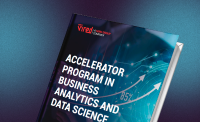In the dynamic landscape of machine learning, maximizing model performance is a perpetual pursuit. One powerful strategy that has gained significant attention is ensemble learning, specifically boosting.
Ensemble methods combine multiple models to create a stronger, more accurate predictor. Boosting, a prominent technique in this realm focuses on sequentially refining models by emphasizing the misclassified instances.
In the section below, we’ll delve into ensemble learning and its centerpiece, boosting, unveiling how this approach magnifies predictive prowess, mitigates overfitting, and unleashes a new level of AI proficiency.
So, let’s get started.


Get curriculum highlights, career paths, industry insights and accelerate your data science journey.
Download brochure
Why Ensemble Learning Works?
Ensemble learning works because it taps into the idea that multiple heads are often better than one. It’s like assembling a team of experts to solve a problem: each expert has their own insights and limitations, but when their opinions are combined, the outcome tends to be more accurate and dependable.
Similarly, ensemble learning combines various machine learning models, trained in different ways, to make predictions.
The genius of ensemble learning is that it takes advantage of the strengths of each model while compensating for their weaknesses.
Mistakes made by one model can be corrected by another, leading to more reliable predictions.
Boosting, a type of ensemble learning, refines models by learning from their past errors, making them progressively more precise.
Furthermore, ensemble learning provides a safety net against overfitting, where a model becomes too tailored to the training data and needs help with new data.
Learn more about the Major Differences Between Data Science and Artificial Intelligence.
Types of Ensemble Learning
Boosting
Boosting is like mentoring a group of models to improve together over time. It works by training a series of models sequentially, where each new model gives more weight to the instances that the previous models struggled to classify accurately.
This process encourages the ensemble to focus on its past mistakes, gradually refining its predictions with each iteration. The final prediction is then determined by combining the predictions of all the models in a weighted manner.
A popular algorithm in boosting is AdaBoost (Adaptive Boosting), which assigns higher importance to misclassified instances to help the ensemble adapt and learn from them.
Bagging (Bootstrap Aggregating)
Bagging is like creating a committee of experts who each make their own decision, and then the committee’s verdict is taken as the final choice.
In bagging, multiple models are trained independently on randomly sampled subsets of the training data, with replacement. This diversity in training sets ensures that the models capture different patterns and aspects of the data.
When making predictions, the results of all models are combined, often through a majority vote for classification or averaging for regression.
Random Forest is a well-known example of a bagging algorithm, where decision trees are trained on these different subsets, and their combined outcome leads to a more robust prediction.
H3. Stacking
Stacking is akin to building a meta-model that learns from the opinions of various experts. It involves training multiple diverse models, just like in bagging, but instead of simply combining their predictions, a new model (meta-model or blender) is trained to make predictions based on the outputs of the initial models.
This approach can capture higher-level patterns and correlations that individual models might miss. Stacking requires a two-step process: the initial models make predictions on new data, and then the meta-model uses these predictions as inputs to make the final prediction.
It’s like having a second layer of decision-making that combines the strengths of the initial models.
Popular Boosting Algorithms
AdaBoost
AdaBoost is a pioneering boosting algorithm that focuses on improving model accuracy by giving more attention to incorrectly predicted instances.
Each iteration assigns higher weights to misclassified instances, prompting subsequent models to pay closer attention to those cases. This iterative process creates a series of models, each learning from the mistakes of the previous one.
AdaBoost then combines these models’ predictions through a weighted vote to produce the final prediction. It’s particularly effective in scenarios with a lot of noise in the data or when dealing with weak learners (models slightly better than random guessing).
Click here to know about the concept of Expert System in Artificial Intelligence.
Gradient Boosting
Gradient Boosting is another powerful boosting technique. It sequentially constructs models, but instead of focusing solely on misclassified instances, it targets the residuals (the differences between actual and predicted values).
Each new model in the sequence aims to predict these residuals more accurately than its predecessors, gradually reducing the errors. These models are then combined to form a robust ensemble.
Gradient Boosting is known for handling various data types and producing highly accurate predictions.
XGBoost
XGBoost is a popular and efficient implementation of gradient boosting. It enhances the concept by adding regularization and optimization techniques to minimize overfitting and improve training speed.
XGBoost also allows for handling missing values, supports parallel processing, and provides a flexible framework for fine-tuning various hyperparameters.
It’s known for its excellent predictive performance, making it a go-to choice for many machine-learning competitions and real-world applications.

Implementing Ensemble Learning
Implementing ensemble learning involves combining multiple models to create a more accurate and robust prediction system. The general process involves:
- Selecting Diverse Models: Choose various base models, which can be decision trees, linear models, support vector machines, or any other model that works well for the problem.
- Training the Base Models: Train each of these models on the same training data, but using different techniques or subsets of the data to introduce diversity.
- Combining Predictions: For prediction, collect the output from each model and combine them. This can be done through voting (for classification) or averaging (for regression).
- Tuning Hyperparameters: Adjust the hyperparameters of the ensemble, such as the number of base models or their weights, to optimize performance.
- Cross-Validation: Validate the ensemble’s performance using techniques like cross-validation to ensure it generalizes well to unseen data.
Conclusion
Ensemble learning, mainly through boosting techniques, unveils a dynamic approach to amplify model performance. Ensemble methods illuminate the path to heightened accuracy and robust predictions by harnessing the collective power of diverse models.
Boosting, in its iterative pursuit of refining models through learning from errors, showcases the potential for continuous improvement. Ensemble learning conquers challenges like overfitting through synergy and balance and enhances predictive abilities.
As we navigate the intricate landscape of machine learning, embracing the collaboration of models stands as a testament to the remarkable potential of combining individual strengths to achieve exceptional outcomes. If you want to learn more about Data Science, Artificial Intelligence & Machine Learning, check out the course by Hero Vired!
FAQs
Boosting techniques in ensemble learning are a set of strategies that focus on iteratively improving the performance of models by learning from their mistakes.
In boosting, models are trained sequentially, with each new model giving extra attention to instances that previous models misclassified.
By emphasizing the difficult cases, boosting aims to create a strong ensemble where each model complements the weaknesses of others.
An ensemble learning model is a collaborative approach combining multiple individual models to make predictions. These models could be different algorithms or variations of the same algorithm.
Combination schemes refer to how the predictions of these individual models are aggregated to produce a final prediction.
Methods like voting, averaging, or using more advanced techniques like stacking are employed to merge the outputs of the models into a coherent prediction.
An Ensemble Method is a technique that improves the performance of a machine-learning model by combining the predictions of multiple models. It leverages the diversity and strengths of different models to create a more accurate and robust predictor.
By reducing the impact of individual models' errors and biases, ensemble methods enhance generalization, mitigate overfitting, and provide more reliable results than a single model.
Ensemble learning is an essential technique in machine learning that combines multiple models to improve the performance of a prediction model.
In contrast to conventional single-model approaches, ensemble techniques result in higher accuracy and more robust predictions.
The main goal of ensemble learning is to combine the knowledge obtained from multiple learners and create a better predictive model.
Ensemble performance is a great tool to get the best out of any system. The idea behind it is that, instead of relying on one single model or algorithm, you can combine multiple models and algorithms together and obtain better results.
This comes with many advantages: increased accuracy, flexibility in how you can build your ensemble, and more robustness against data noise.










